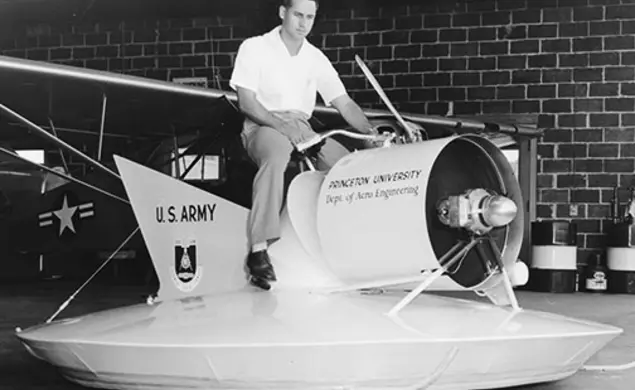Flying Saucers at Forrestal
 W. Barry Nixon *60 test drives the Air Scooter in 1959.
W. Barry Nixon *60 test drives the Air Scooter in 1959.
It’s strange to recall, but at the height of the Cold War the University had its own airport at the Forrestal campus where faculty scientists tested experimental flying vehicles, in collaboration with the U.S. Army.
Our flying saucers weren’t intended for the space race — they rose just four inches off the grass. Yet such floating “ground-effect” vehicles seemed to promise a transportation revolution in 1959, the year a pioneering hovercraft first crossed the English Channel.
The Air Scooter, announced in September of that year, was the brainchild of legendary aeronautical engineering professor Courtland Perkins, a World War II expert on the control of aircraft and a daring pilot. He and researcher Tom Sweeney dreamed of an airplane that could touch down anywhere — with no landing gear — and that soldiers could fly without training, steering it just by shifting their weight around.
As a first step toward such a “body-control” craft, the Air Scooter’s driver sat on a bicycle seat and grasped handlebars. A gas engine taken from a chainsaw blasted a cushion of air beneath the aluminum-and-fabric body, allowing the Air Scooter to glide over the fields at 15 miles per hour.
Upon its debut, the odd machine garnered much press, with one reporter saying that “guiding this beast is like steering wet Jell-O around a plate.” Drawbacks were obvious: its deafening roar and wobbling in the wind.
Princeton built a few more hovercraft into the 1960s and even planned — but never produced — a floating wheelbarrow for construction workers. The P-GEM Flying Doughnut, resembling a B-movie Martian spacecraft, was 20 feet across and powered by two engines. Motorists stared when a similar device glided across Route 1 to spray a potato crop.
Not long after, these colorful experiments ceased. Princeton’s surviving crafts went to museums, footnotes to a creative postwar era better known for helicopters, jets, and rockets.
The Latest
See all






